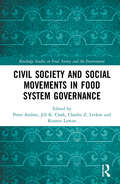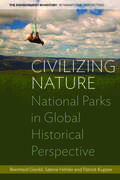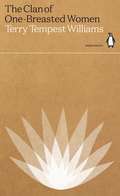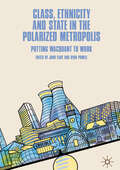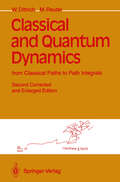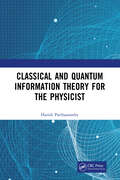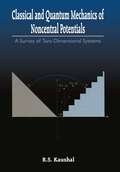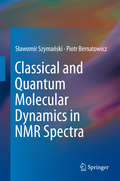- Table View
- List View
Civil Engineering Applications of Ground Penetrating Radar (Springer Transactions in Civil and Environmental Engineering)
by Andrea Benedetto Lara PajewskiThis book, based on Transport and Urban Development COST Action TU1208, presents the most advanced applications of ground penetrating radar (GPR) in a civil engineering context, with documentation of instrumentation, methods and results. It explains clearly how GPR can be employed for the surveying of critical transport infrastructure, such as roads, pavements, bridges and tunnels and for the sensing and mapping of underground utilities and voids. Detailed attention is also devoted to use of GPR in the inspection of geological structures and of construction materials and structures, including reinforced concrete, steel reinforcing bars and pre/post-tensioned stressing ducts. Advanced methods for solution of electromagnetic scattering problems and new data processing techniques are also presented. Readers will come to appreciate that GPR is a safe, advanced, non destructive and noninvasive imaging technique that can be effectively used for the inspection of composite structures and the performance of diagnostics relevant to the entire life cycle of civil engineering works.
Civil Engineering for Disaster Risk Reduction (Springer Tracts in Civil Engineering)
by Sreevalsa Kolathayar Indrajit Pal Siau Chen Chian Arpita MondalThe book is a comprehensive volume on multi-hazards and their management for a sustainable built environment. It focuses on the role of civil engineering in building disaster resilient society. This book brings together all diverse disciplines of civil engineering and related areas (for example, geotechnical engineering, water resources engineering, structural engineering, transportation engineering, environmental engineering, construction management, GIS, and remote sensing) towards a common goal of disaster resilience through an interdisciplinary approach. It contains methods and case studies focusing on civil engineering solutions to reduce the disaster risk. The book contents are aligned in line with the priorities set by UN-Sendai Framework for Disaster Risk Reduction and UN-SDGs to promote a global culture of risk-awareness and disaster reduction. The book will be a useful comprehensive reference for disaster risk reduction beneficial for engineering students, teaching faculty, researchers, industry professionals and policymakers.
Civil Society and Social Movements in Food System Governance (Routledge Studies in Food, Society and the Environment)
by Peter Andrée Jill K. Clark Charles Z. Levkoe Kristen LowittThis book offers insights into the governance of contemporary food systems and their ongoing transformation by social movements. As global food systems face multiple threats and challenges there is an opportunity for social movements and civil society to play a more active role in building social justice and ecological sustainability. Drawing on case studies from Canada, the United States, Europe and New Zealand, this edited collection showcases promising ways forward for civil society actors to engage in governance. The authors address topics including: the variety of forms that governance engagement takes from multi-stakeholderism to co-governance to polycentrism/self-governance; the values and power dynamics that underpin these different types of governance processes; effective approaches for achieving desired values and goals; and, the broader relationships and networks that may be activated to support change. By examining and comparing a variety of governance innovations, at a range of scales, the book offers insights for those considering contemporary food systems and their ongoing transformation. It is suitable for food studies students and researchers within geography, environmental studies, anthropology, policy studies, planning, health sciences and sociology, and will also be of interest to policy makers and civil society organisations with a focus on food systems. The Open Access version of this book, available at http://www.tandfebooks.com/doi/view/10.4324/9780429503597, has been made available under a Creative Commons Attribution-Non Commercial-No Derivatives 4.0 license.
Civil Society and Social Movements in Food System Governance (Routledge Studies in Food, Society and the Environment)
by Peter Andrée Jill K. Clark Charles Z. Levkoe Kristen LowittThis book offers insights into the governance of contemporary food systems and their ongoing transformation by social movements. As global food systems face multiple threats and challenges there is an opportunity for social movements and civil society to play a more active role in building social justice and ecological sustainability. Drawing on case studies from Canada, the United States, Europe and New Zealand, this edited collection showcases promising ways forward for civil society actors to engage in governance. The authors address topics including: the variety of forms that governance engagement takes from multi-stakeholderism to co-governance to polycentrism/self-governance; the values and power dynamics that underpin these different types of governance processes; effective approaches for achieving desired values and goals; and, the broader relationships and networks that may be activated to support change. By examining and comparing a variety of governance innovations, at a range of scales, the book offers insights for those considering contemporary food systems and their ongoing transformation. It is suitable for food studies students and researchers within geography, environmental studies, anthropology, policy studies, planning, health sciences and sociology, and will also be of interest to policy makers and civil society organisations with a focus on food systems. The Open Access version of this book, available at http://www.tandfebooks.com/doi/view/10.4324/9780429503597, has been made available under a Creative Commons Attribution-Non Commercial-No Derivatives 4.0 license.
Civil Society Organization and Disaster Risk Reduction: The Asian Dilemma (Disaster Risk Reduction)
by Rajib Shaw Takako IzumiCivil society organizations (CSOs) have played important roles over the years in the disaster field. Starting from the traditional approach of response and relief, the emphasis has gradually shifted to disaster risk reduction. From international nongovernmental organizations (NGOs) to national and local NGOs, all stakeholders have recognized the significance of and need for community-based risk reduction. In their different capacities they have endeavored to establish links to the policy options at the local and national levels. There still are many issues that remain untouched by CSOs, however, and local CSOs face special challenges in resources in terms of human, financial, and technical issues. Drawing examples from Asia, this book is structured on the roles of CSOs according to the Hyogo Framework for Action priority areas: policy making, risk assessment, education and training, underlying risk factors, and response–recovery. The primary target groups for this book are students and researchers in the fields of environment, disaster risk reduction, and climate change studies. The book provides a clear view of the current trends of research in the field and furnishes basic knowledge on these important topics. Another target group comprises practitioners and policy makers, who will be able to apply the knowledge collected here to policy and decision making.
Civil Society Sustainability: New challenges in organisational legitimacy, credibility, and viability
by Brian Pratt and Rachel HaymanThis publication focuses on the challenges faced by civil society to remain sustainable in response to major changes in the global political, economic and social environment. Academics and practitioners from all over the world have contributed original articles, practical notes and viewpoints which critically examine the ways in which civil society organisations are affected by and are responding to political and financial dynamics. These include reductions in traditional external aid for civil society activities, but also the growth of new forms of funding through social enterprise, philanthropy, fundraising and contractual relationships with national government. The operating environment for civil society is a central theme, with authors exploring the legitimacy and credibility of different types of civil society organisation, as well as the effects of legislative and regulatory restrictions on their sustainability. The contributions finally examine new opportunities for civil society and the prospects for organisations to emerge that are less dependent on foreign aid funding, that are more embedded in local communities, and that can bring about lasting and sustained social and economic change. This book was originally published as a special issue of Development in Practice.
Civil Society Sustainability: New challenges in organisational legitimacy, credibility, and viability
by Brian Pratt Rachel HaymanThis publication focuses on the challenges faced by civil society to remain sustainable in response to major changes in the global political, economic and social environment. Academics and practitioners from all over the world have contributed original articles, practical notes and viewpoints which critically examine the ways in which civil society organisations are affected by and are responding to political and financial dynamics. These include reductions in traditional external aid for civil society activities, but also the growth of new forms of funding through social enterprise, philanthropy, fundraising and contractual relationships with national government. The operating environment for civil society is a central theme, with authors exploring the legitimacy and credibility of different types of civil society organisation, as well as the effects of legislative and regulatory restrictions on their sustainability. The contributions finally examine new opportunities for civil society and the prospects for organisations to emerge that are less dependent on foreign aid funding, that are more embedded in local communities, and that can bring about lasting and sustained social and economic change. This book was originally published as a special issue of Development in Practice.
Civil Structural Health Monitoring: Proceedings of CSHM-9 Workshop (Lecture Notes in Civil Engineering #516)
by Waleed Abdullah Muhammad Tariq Chaudhary Hasan Kamal Jafarali Parol Abdullah AlmutairiThis book gathers the latest advances and innovations in the field of structural health monitoring, as presented at the 9th Civil Structural Health Monitoring Workshop (CSHM-9), held in Kuwait on February 12–14, 2024. It discusses emerging challenges in civil SHM and more broadly in the fields of smart materials and intelligent systems for civil engineering applications. The contributions cover a diverse range of topics, including applications of SHM to civil structures and infrastructures, innovative sensing solutions for SHM, data-driven damage detection techniques, nonlinear systems and analysis techniques, influence of environmental and operational conditions, aging structures and infrastructures in hazardous environments, and SHM in earthquake prone regions. Selected by means of a rigorous peer-review process, they will spur novel research directions and foster future multidisciplinary collaborations.
Civil Structural Health Monitoring: Proceedings of CSHM-8 Workshop (Lecture Notes in Civil Engineering #156)
by Carlo Rainieri Giovanni Fabbrocino Nicola Caterino Francesca Ceroni Matilde A. NotarangeloThis volume gathers the latest advances and innovations in the field of structural health monitoring, as presented at the 8th Civil Structural Health Monitoring Workshop (CSHM-8), held on March 31–April 2, 2021. It discusses emerging challenges in civil SHM and more broadly in the fields of smart materials and intelligent systems for civil engineering applications. The contributions cover a diverse range of topics, including applications of SHM to civil structures and infrastructures, innovative sensing solutions for SHM, data-driven damage detection techniques, nonlinear systems and analysis techniques, influence of environmental and operational conditions, aging structures and infrastructures in hazardous environments, and SHM in earthquake prone regions. Selected by means of a rigorous peer-review process, they will spur novel research directions and foster future multidisciplinary collaborations.
Civilizing Nature: National Parks in Global Historical Perspective (Environment in History: International Perspectives #1)
by Bernhard Gissibl, Sabine Höhler and Patrick KupperNational parks are one of the most important and successful institutions in global environmentalism. Since their first designation in the United States in the 1860s and 1870s they have become a global phenomenon. The development of these ecological and political systems cannot be understood as a simple reaction to mounting environmental problems, nor can it be explained by the spread of environmental sensibilities. Shifting the focus from the usual emphasis on national parks in the United States, this volume adopts an historical and transnational perspective on the global geography of protected areas and its changes over time. It focuses especially on the actors, networks, mechanisms, arenas, and institutions responsible for the global spread of the national park and the associated utilization and mobilization of asymmetrical relationships of power and knowledge, contributing to scholarly discussions of globalization and the emergence of global environmental institutions and governance.
CKW, FCKW und Lösungsmittel: Optimierter Einsatz und Ersatz in der betrieblichen Praxis
by Jan U. Lieback Peter Herger Ralf FreiseFluorchlorkohlenwasserstoffe (FCKW) und Chlorkohlenwasserstoffe (CKW) zerstören maßgeblich die lebenserhaltende Ozonschicht und tragen in erheblichem Umfang zum Treibhauseffekt bei. Dennoch werden diese Stoffe weiterhin zur Reinigung, zur Kunststoffherstellung, als Treibgas, als Lösungsmittel und zur Kälteerzeugung eingesetzt. Das Buch gibt ein übergreifendes Bild dieser Problematik. Es werden Einzelaspekte aus der betrieblichen Praxis, wie Lagerung, Transport und Entsorgung verbrauchter Lösemittel geschildert und Ersatzprodukte sowie neue Verfahren beschrieben. Auch rechtliche Aspekte werden nicht ausgespart. Das Buch wendet sich insbesondere an industrielle Anwender und an interessierte Fachleute im Bereich der Umwelttechnik.
Clan and Tribal Perspectives on Social, Economic and Environmental Sustainability: Indigenous Stories From Around the Globe
by James C. Spee, Adela Mcmurray, Mark McmillanFrom the Indigenous perspective, sustainability must be understood as a means of survival. In a climate of in-migration, clan and tribal communities have been forced to build sustainable solutions together to protect their sovereignty, recognition and mutual respect. In the midst of a global pandemic that threatens the economic and social well-being of millions of people, this edited collection addresses the social, economic, and environmental sustainability of tribes, clans, and Indigenous cultures across national and global origins. Acknowledging that these peoples around the globe have addressed threats to their survival for millennia, the authors showcase examples of indigenous groups spanning South Africa, Nigeria, Australia, New Zealand, Pakistan, Afghanistan, Bolivia and North America. Regional examples also come from Rwanda, Cameroon, Congo, Ethiopia, East Timor, Papua New Guinea, the Andaman and Nicobar Islands, Easter Island, and Nunavit, Canada. Breaking fresh ground by shining a light on sustainability journeys from outside the global mainstream, this book demonstrates how sustainable recovery and development occurs in respectful collaboration between equals.
Clan and Tribal Perspectives on Social, Economic and Environmental Sustainability: Indigenous Stories From Around the Globe
by James C. Spee Adela J. McMurray Mark D. McMillanFrom the Indigenous perspective, sustainability must be understood as a means of survival. In a climate of in-migration, clan and tribal communities have been forced to build sustainable solutions together to protect their sovereignty, recognition and mutual respect. In the midst of a global pandemic that threatens the economic and social well-being of millions of people, this edited collection addresses the social, economic, and environmental sustainability of tribes, clans, and Indigenous cultures across national and global origins. Acknowledging that these peoples around the globe have addressed threats to their survival for millennia, the authors showcase examples of indigenous groups spanning South Africa, Nigeria, Australia, New Zealand, Pakistan, Afghanistan, Bolivia and North America. Regional examples also come from Rwanda, Cameroon, Congo, Ethiopia, East Timor, Papua New Guinea, the Andaman and Nicobar Islands, Easter Island, and Nunavit, Canada. Breaking fresh ground by shining a light on sustainability journeys from outside the global mainstream, this book demonstrates how sustainable recovery and development occurs in respectful collaboration between equals.
The Clan of One-Breasted Women (Green Ideas)
by Terry Tempest WilliamsIn twenty short books, Penguin brings you the classics of the environmental movement.With honesty, passion and heart, Terry Tempest Williams's essays explore the impact of nuclear testing, the vital importance of environmental legislation, and the guiding spirit of conservation.Over the past 75 years, a new canon has emerged. As life on Earth has become irrevocably altered by humans, visionary thinkers around the world have raised their voices to defend the planet, and affirm our place at the heart of its restoration. Their words have endured through the decades, becoming the classics of a movement. Together, these books show the richness of environmental thought, and point the way to a fairer, saner, greener world.
Class, Ethnicity and State in the Polarized Metropolis: Putting Wacquant to Work
by John Flint Ryan PowellLoïc Wacquant is one of the most influential sociological theorists of the contemporary era with his research and writings resonating widely across the social sciences. This edited collection critically responds to Wacquant’s distinct approach to understanding the contemporary urban condition in advanced capitalist societies. It comprises chapters focused on Europe and North America from leading international scholars and new emergent voices, which chart new empirical, theoretical and methodological territory. Pivoting on the relationship between class, ethnicity and the state in the (re-)making of urban marginality, the volume takes stock of Wacquant’s body of work and assesses its value as a springboard for rethinking urban inequality in polarizing times. Heeding Wacquant’s call for constant theoretical critique and development in understanding dynamic urban relations and processes, the contributions challenge, develop and refine Wacquant’s framework, while also synthesizing it with other perspectives and bringing it into dialogue with new areas of inquiry. How can Wacquant’s work aid the empirical understanding of today’s complex urban inequalities? And how can empirical investigation and theoretical synthesis aid the development of Wacquant’s framework? The diverse contributors to the collection ask these, and other, searching questions – and Wacquant responds to this critique in the final chapter. This book will be of interest to scholars engaged in understanding the drivers, contexts, and potential responses to contemporary urban marginality.
Classical Analogies in the Solution of Quantum Many-Body Problems
by Aydın Cem KeserThis book addresses problems in three main developments in modern condensed matter physics– namely topological superconductivity, many-body localization and strongly interacting condensates/superfluids–by employing fruitful analogies from classical mechanics. This strategy has led to tangible results, firstly in superconducting nanowires: the density of states, a smoking gun for the long sought Majorana zero mode is calculated effortlessly by mapping the problem to a textbook-level classical point particle problem. Secondly, in localization theory even the simplest toy models that exhibit many-body localization are mathematically cumbersome and results rely on simulations that are limited by computational power. In this book an alternative viewpoint is developed by describing many-body localization in terms of quantum rotors that have incommensurate rotation frequencies, an exactly solvable system. Finally, the fluctuations in a strongly interacting Bose condensate and superfluid, a notoriously difficult system to analyze from first principles, are shown to mimic stochastic fluctuations of space-time due to quantum fields. This analogy not only allows for the computation of physical properties of the fluctuations in an elegant way, it sheds light on the nature of space-time. The book will be a valuable contribution for its unifying style that illuminates conceptually challenging developments in condensed matter physics and its use of elegant mathematical models in addition to producing new and concrete results.
Classical and Advanced Theories of Thin Structures: Mechanical and Mathematical Aspects (CISM International Centre for Mechanical Sciences)
by Antonio Morassi Roberto ParoniThe book presents an updated state-of-the-art overview of the general aspects and practical applications of the theories of thin structures, through the interaction of several topics, ranging from non-linear thin-films, shells, junctions, beams of different materials and in different contexts (elasticity, plasticity, etc.). Advanced problems like the optimal design and the modeling of thin films made of brittle or phase-transforming materials will be presented as well.
Classical and Quantum Cosmology (Graduate Texts in Physics)
by Gianluca CalcagniThis comprehensive textbook is devoted to classical and quantum cosmology, with particular emphasis on modern approaches to quantum gravity and string theory and on their observational imprint. It covers major challenges in theoretical physics such as the big bang and the cosmological constant problem. An extensive review of standard cosmology, the cosmic microwave background, inflation and dark energy sets the scene for the phenomenological application of all the main quantum-gravity and string-theory models of cosmology. Born of the author's teaching experience and commitment to bridging the gap between cosmologists and theoreticians working beyond the established laws of particle physics and general relativity, this is a unique text where quantum-gravity approaches and string theory are treated on an equal footing. As well as introducing cosmology to undergraduate and graduate students with its pedagogical presentation and the help of 45 solved exercises, this book, which includes an ambitious bibliography of about 3500 items, will serve as a valuable reference for lecturers and researchers.
Classical and Quantum Dynamics: From Classical Paths to Path Integrals (Graduate Texts In Physics Ser.)
by Walter Dittrich Martin ReuterGraduate students seeking to become familiar with advanced computational strategies in classical and quantum dynamics will find in this book both the fundamentals of a standard course and a detailed treatment of the time-dependent oscillator, Chern-Simons mechanics, the Maslov anomaly and the Berry phase, to name just a few topics. Well-chosen and detailed examples illustrate perturbation theory, canonical transformations and the action principle, and demonstrate the usage of path integrals. The sixth edition has been enlarged to include the Heisenberg-Euler Lagrangian, Schwinger’s source theory treatment of the low-energy π-ρ-N physics and general relativity, where Riemann’s (Einstein’s) ideas on space and time and their philosophical implications are discussed.
Classical and Quantum Dynamics: from Classical Paths to Path Integrals
by Walter Dittrich Martin ReuterIn the past 10 to 15 years, the quantum leap in understanding of nonlinear dynamics has radically changed the frame of reference of physicists contemplating such systems. This book treats classical and quantum mechanics using an approach as introduced by nonlinear Hamiltonian dynamics and path integral methods. It is written for graduate students who want to become familiar with the more advancedcomputational strategies in classical and quantum dynamics. Therefore, worked examples comprise a large part of the text. While the first half of the book lays the groundwork for a standard course, the second half, with its detailed treatment of the time-dependent oscillator, classical and quantum Chern-Simons mechanics, the Maslov anomaly and the Berry phase, willacquaint the reader with modern topological methods that have not as yet found their way into the textbook literature.
Classical and Quantum Dynamics: from Classical Paths to Path Integrals
by Walter Dittrich Martin ReuterGraduate students wishing to become familiar with advanced computational strategies in classical and quantum dynamics will find in the one source both the fundamentals of a standard course as well as a detailed treatment of the time-dependent oscillator, Chern-Simons mechanics, the Maslov anomaly and the Berry phase, illustrated by many worked examples throughout the text. This second edition has been enlarged with a new chapter on topological phases in planar electrodynamics, and a discussion of the Aharonov-Bohm effect.
Classical and Quantum Information Theory for the Physicist
by Harish ParthasarathyThis book deals with certain important problems in Classical and Quantum Information Theory Quantum Information Theory, A Selection of Matrix Inequalities Stochastic Filtering Theory Applied to Electromagnetic Fields and Strings Wigner-distributions in Quantum Mechanics Quantization of Classical Field Theories Statistical Signal Processing Quantum Field Theory, Quantum Statistics, Gravity, Stochastic Fields and Information Problems in Information Theory It will be very helpful for students of Undergraduate and Postgraduate Courses in Electronics, Communication and Signal Processing. Print edition not for sale in South Asia (India, Sri Lanka, Nepal, Bangladesh, Pakistan or Bhutan).
Classical and Quantum Information Theory for the Physicist
by Harish ParthasarathyThis book deals with certain important problems in Classical and Quantum Information Theory Quantum Information Theory, A Selection of Matrix Inequalities Stochastic Filtering Theory Applied to Electromagnetic Fields and Strings Wigner-distributions in Quantum Mechanics Quantization of Classical Field Theories Statistical Signal Processing Quantum Field Theory, Quantum Statistics, Gravity, Stochastic Fields and Information Problems in Information Theory It will be very helpful for students of Undergraduate and Postgraduate Courses in Electronics, Communication and Signal Processing. Print edition not for sale in South Asia (India, Sri Lanka, Nepal, Bangladesh, Pakistan or Bhutan).
Classical and Quantum Mechanics of Noncentral Potentials: A Survey of Two-Dimensional Systems
by Radhey S. KaushalNon-central forces have a wide variety of applications in classical and quantum mechanics as demonstrated in this book. The author emphasizes the study of time-dependent potentials, predominantly in two dimensions, without neglecting the quite well understood time-independent case. The construction of invariants in the classical case and the study of solutions to Schrödinger's equation, as well as a detailed presentation of various mathematical techniques are of main concern to the author. The book addresses theoretical physicists and mathematicians, but it will also be useful for electrical and mechanical engineers.
Classical and Quantum Molecular Dynamics in NMR Spectra
by Piotr Bernatowicz Sławomir SzymańskiThe book provides a detailed account of how condensed-phase molecular dynamics are reflected in the line shapes of NMR spectra. The theories establishing connections between random, time-dependent molecular processes and lineshape effects are exposed in depth. Special emphasis is placed on the theoretical aspects, involving in particular intermolecular processes in solution, and molecular symmetry issues. The Liouville super-operator formalism is briefly introduced and used wherever it is beneficial for the transparency of presentation. The proposed formal descriptions of the discussed problems are sufficiently detailed to be implemented on a computer. Practical applications of the theory in solid- and liquid-phase studies are illustrated with appropriate experimental examples, exposing the potential of the lineshape method in elucidating molecular dynamics NMR-observable molecular phenomena where quantization of the spatial nuclear degrees of freedom is crucial are addressed in the last part of the book. As an introduction to this exciting research field, selected aspects of the quantum mechanics of isolated systems undergoing rotational tunnelling are reviewed, together with some basic information about quantum systems interacting with their condensed environment. The quantum theory of rate processes evidenced in the NMR lineshapes of molecular rotors is presented, and illustrated with appropriate experimental examples from both solid- and liquid-phase spectra. In this context, the everlasting problem of the quantum-to-classical transition is discussed at a quantitative level. The book will be suitable for graduate students and new and practising researchers using NMR techniques.


